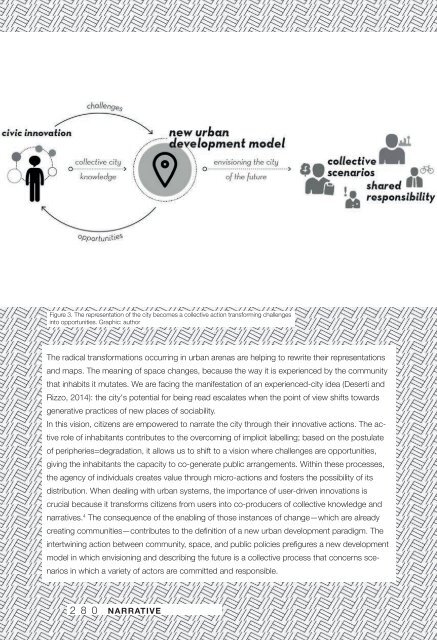Dynamics of Periphery
978-3-86859-511-6 https://www.jovis.de/de/buecher/vorschau/product/dynamics_of_periphery.html
978-3-86859-511-6
https://www.jovis.de/de/buecher/vorschau/product/dynamics_of_periphery.html
You also want an ePaper? Increase the reach of your titles
YUMPU automatically turns print PDFs into web optimized ePapers that Google loves.
Figure 3. The representation <strong>of</strong> the city becomes a collective action transforming challenges<br />
into opportunities. Graphic: author<br />
The radical transformations occurring in urban arenas are helping to rewrite their representations<br />
and maps. The meaning <strong>of</strong> space changes, because the way it is experienced by the community<br />
that inhabits it mutates. We are facing the manifestation <strong>of</strong> an experienced-city idea (Deserti and<br />
Rizzo, 2014): the city's potential for being read escalates when the point <strong>of</strong> view shifts towards<br />
generative practices <strong>of</strong> new places <strong>of</strong> sociability.<br />
In this vision, citizens are empowered to narrate the city through their innovative actions. The active<br />
role <strong>of</strong> inhabitants contributes to the overcoming <strong>of</strong> implicit labelling; based on the postulate<br />
<strong>of</strong> peripheries=degradation, it allows us to shift to a vision where challenges are opportunities,<br />
giving the inhabitants the capacity to co-generate public arrangements. Within these processes,<br />
the agency <strong>of</strong> individuals creates value through micro-actions and fosters the possibility <strong>of</strong> its<br />
distribution. When dealing with urban systems, the importance <strong>of</strong> user-driven innovations is<br />
crucial because it transforms citizens from users into co-producers <strong>of</strong> collective knowledge and<br />
narratives. 4 The consequence <strong>of</strong> the enabling <strong>of</strong> those instances <strong>of</strong> change—which are already<br />
creating communities—contributes to the definition <strong>of</strong> a new urban development paradigm. The<br />
intertwining action between community, space, and public policies prefigures a new development<br />
model in which envisioning and describing the future is a collective process that concerns scenarios<br />
in which a variety <strong>of</strong> actors are committed and responsible.<br />
280<br />
NARRATIVE


















